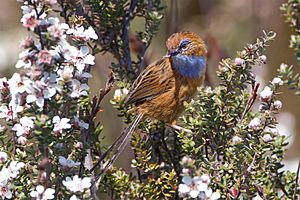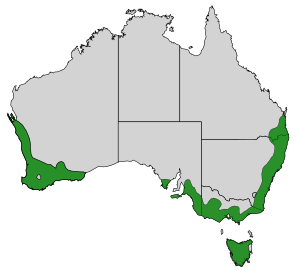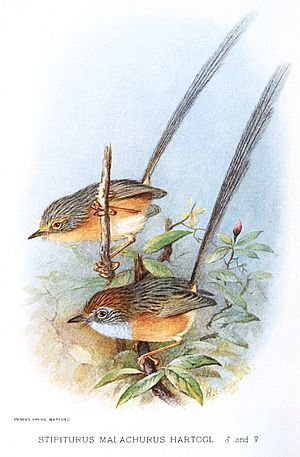Southern emu-wren facts for kids
Quick facts for kids Southern emu-wren |
|
|---|---|
 |
|
| Male in Tasmania | |
| Conservation status | |
| Scientific classification | |
 |
|
| Distribution map | |
| Synonyms | |
|
The southern emu-wren (Stipiturus malachurus) is a small, unique bird found only in Australia. It belongs to the Australasian wren family, called Maluridae. These birds get their name from their special tail feathers. These feathers look a bit like the feathers of a large emu! Southern emu-wrens usually live in forests and bushy areas.
Contents
About the Southern Emu-Wren Name
The southern emu-wren is one of three types of birds in the Stipiturus group. These birds are often called emu-wrens. They are found across southern and central Australia.
The first person to describe this bird was a naturalist named George Shaw in 1798. He called it Muscicapa malachura. This happened after a bird was found near Port Jackson (which is now Sydney). People at the time called it the "soft-tailed flycatcher." Local Aboriginal people had names for it too, like mur-re-a-nera and mereangeree.
The southern emu-wren gets its common name from its tail feathers. These feathers are very soft and loose, much like the feathers of an emu. It's quite funny because emu-wrens are among the smallest birds in Australia. But the emu is the largest bird there!
Different Types of Southern Emu-Wrens
Scientists have found up to eleven different kinds of southern emu-wrens. Today, eight of these are officially recognized:
- S. m. malachurus - (Shaw, 1798): This type lives along the eastern coast. You can find it from Noosa Heads in Queensland down through New South Wales and Victoria. It also lives near the mouth of the Murray River in south-eastern South Australia. It stays east and south of the Great Dividing Range.
- S. m. littleri - (Mathews, 1912): This type lives all over Tasmania.
- S. m. polionotum - (Schodde & Ian J. Mason, 1999): This type is found in south-central and south-eastern Australia.
- S. m. intermedius - (Ashby, 1920): This type has darker feathers. It lives in the Mount Lofty Ranges in South Australia.
- S. m. halmaturinus - (Parsons, 1920): This type lives on Kangaroo Island. It is the largest kind of southern emu-wren.
- S. m. parimeda - (Schodde & Weatherly, 1981): This type is found at the very southern tip of the Eyre Peninsula. You can tell this type apart because its feathers are much paler.
- S. m. westernensis - (Campbell, AJ, 1912): This type lives in south-western Western Australia.
- S. m. hartogi - (Carter, 1916): This type only lives on Dirk Hartog Island.
What Southern Emu-Wrens Look Like
Adult male southern emu-wrens have rusty-brown feathers on their upper body. These feathers have black streaks. Their head is more reddish, and their wings are grey-brown. They have a sky blue throat, upper chest, and a blue stripe above their eye.
Their tail is very long, about twice the length of their body. It has six thin, hair-like feathers. The two feathers in the middle are longer than the ones on the sides. Their belly is a pale red-brown color, becoming lighter towards the very bottom. The beak is black, and their feet and eyes are brown.
Female southern emu-wrens look a bit different. They have darker streaks on their feathers. They do not have the blue feathers or the reddish head that the males have. Their beak is brown with a pale grey base.
Where Southern Emu-Wrens Live
Southern emu-wrens live in different places across Australia. They like marshes, which are wet, grassy areas. They also live in low heathland, which is an open area with small shrubs. You can also find them in sand dune areas near the coast.
See also
 In Spanish: Maluro meridional para niños
In Spanish: Maluro meridional para niños



